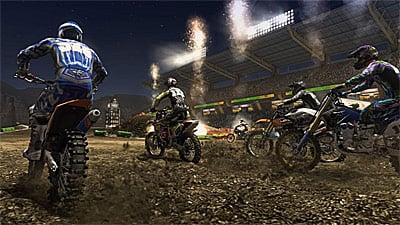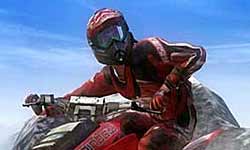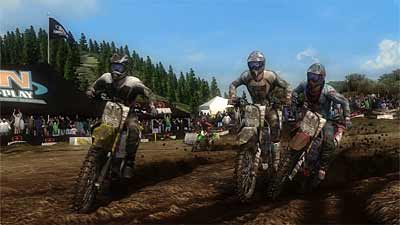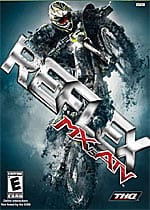Deformation of Character
October 16, 2009 – The market for racing games this holiday season is getting increasingly crowded. In a market dominated by the likes of heavyweights Dirt 2, Need for Speed: Shift, and Forza 3 it’s hard for any racer to differentiate itself from the pack. But a renewed focus and some new key gameplay additions should make sure that MX vs. ATV Reflex can hang tough with the big boys.

Chief among their new additions is the impressive terrain deformation feature that is front and center in this game. At all times, when riding through dirt, snow, or other loose terrain, the tires of the racer will dig into the track and change it for the rest of the race.
It’s not just an aesthetic change, though. It’s an actual divot in the race course that can throw off other racers. In early laps it’s not much of an impact, but towards the end of the race when the track is all torn up, it can make a huge difference and fundamentally change the way the course should best be traversed. MX bikes and ATVs tend to make a more subtle impact on the track, but there’s nothing subtle about the way a racing truck can rip up the terrain.
Because of features like this, during our play session it was obvious that the team is striving to create an experience that was simultaneously more realistic than ever before, but also emphasizing the best aspects – making sure those shine brightest.
The best example of this is in the enhanced focus on the rider’s control over his bike. Not the players control, but the rider’s control. In Reflex, players control the vehicle with the left control stick as usual, but now also control the rider with the right stick.
The way this affects gameplay is it adds a certain depth to making otherwise simple turns. While you could easily make the turn without ever attempting to shift your weight, you can take riskier strategies and faster routes if you slam your weight into the inside of the turn and whip the bike around behind you.

The rider weight control system applies itself to mid-air maneuvers as well. In addition to the normal repertoire of highflying stunts, you can now move your weight around to perform other types of stunts like whips and back flips. It requires a bit more skill than the usual button sequence tricks and forces you to consider things like momentum and landing angle.
Going even further with weight distribution, Reflex seamlessly introduces a sort of quick-time event into riding. This isn’t God of War or Ninja Blade though, so don’t expect to be using QTEs for anything extravagant. It’s much more subtle than those games. As you’re going off jumps, riding up inclines, or careening down a hill, the rider will sometimes lose balance if he’s in a precarious spot. At that point a green arrow shows up on the screen and the player has to quickly adjust the rider’s weight in that direction in order to keep him on the bike instead of face down in the dirt.
It doesn’t seem like much, but the small inclusion of QTEs into riding seems to really add more player interaction with riding. Now even seemingly mundane quests, like struggling to climb to the top of a mountain in Free Ride, becomes a harrowing quest that requires skill and quick reflexes – whereas before it could be as simple as pointing yourself at the summit and pressing the gas.

Developer Rainbow said that Free Ride was one aspect they really wanted to carry over from the last version. It was a big hit with fans of the series, and now the mode is even more developed due to the new terrain deformation features. As much as it can impact a race, terrain deformation takes center stage when your back wheel is digging into the dirt and snow, deeper and deeper, trying to gain traction to get further up a hill.
Free Ride is just one aspect of multiplayer that is returning, though. Rainbow is also including the popular Snake game type, which is about as close to next-gen Tron light cycles as you’re likely to ever get. As players ride through the map, a long colored tail stretches along the path where they’ve ridden. If another rider drives through someone else’s tail, then they’re wrecked and out of the game for the round. It’s a last-man standing type of game and it’s a whole lot of fun when you’re in a full game. Huge trails of light pass through the level, and it only gets more intense as the game progresses. Soon enough there’s only tiny paths for you to travel along, making every moment you manage to stay alive a miraculous struggle.
Obviously, this isn’t the type of mode that’s going to steer you away from Modern Warfare 2 for any significant amount of time, but the multiplayer games we tried were quite fun and will serve to add a lot of additional value to the package for consumers.
Overall, the single best compliment that can be said about Reflex is that it just feels good. Whether you’re zipping around an arena course with massive jumps, trying to scale a mountain, or desperately evading your friends in an online mode, the racing feels visceral. Reflex seems poised to provide fans of the series with everything they’ve come to love, while simultaneously winning over some new ones in the process with impressive new features.
Game Features:
A Long Overdue Fresh Start
June 10, 2009 – It feels like Rainbow Studios has been at the motocross game forever now, but in the last couple years, it’s become apparent that they’ve just been running out of steam. It’s not that the games have been getting worse, but rather that they just seem to have sunk into a rut of the same old gameplay and features. For that reason, we approached the demo for MX vs. ATV: Reflex with a bit of apathy, but we were greeted by a newly energized Rainbow Studios, hard at work reinventing the series. If what we played was any indication, the series may have more life left than we realized.

The most fundamental change comes to the game’s control. Previously you would just steer your vehicle as in any racing game, but this isn’t completely true to the sport. To rectify this, the developers are using the right analog stick to map body movements. This adds a new dimension to riding and doing tricks, and the system was intuitive, if not exactly easy. It took some practice before we got the hang of manipulating the vehicles without wiping out, but the added control is going to be a major asset. Once we got the hang of it, the Rainbow Studios rep showed us how to do circular motions on the right stick to pull off tricks. This system replaces the Tony Hawk inspired button press system, and in fact the face buttons didn’t seem to do anything at all.
The other major new feature is track deformation. Since the last game in the series, Rainbow has managed to get the individual polygons making up the track down from feet to just a few inches, so all the tiny bumps and pits in the road are taken into account. As you go around turns, you’ll pack the dirt down (or in the case of one of the stages shown, snow) and leave behind a groove in the road. This isn’t just for show; these grooves will affect your riding, and they can be used to help round corners and shave small amounts off your time. It’s one of the more subtle elements of real motocross riding that has been neglected in the genre, and it makes for an interesting addition.

We only got to play one actual race, during which the most glaring flaw of the game became apparent: the A.I. needs a lot of work. Opponents weren’t just competitive, they made Road Rash’s racers look like gentlemen. After being run off the road a few times, the rep apologized and said that the A.I. was something that was still fairly early and would undergo a lot of revision. The three other courses we sampled were all freestyle tracks, each with very distinct designs, ranging from a dirt arena, to a snow covered mountain, and a lone stunt course set on pavement – the only such course in the game, we’re told.

Reflex still needs a coat of spit and polish before it’s ready, and it launches in just a few months, but what we played is a very good start. For those who have grown tired of the series, this could be the perfect place to jump back in – we just hope those evil opponents mellow out a bit in the final version.
Game Features:
